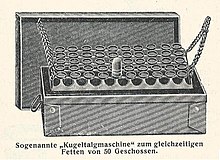Bullet lubrication
The bullet-lubrication is necessary especially with lead bullets, as they lose material when fired from the friction in the barrel inside especially in gezogegen runs. This leads to the inside of the barrel becoming leaded and thus reducing the accuracy of the shot. The bullets must therefore be greased.
Lubricate the bullet surface
Since black powder and certain fats do not go well, the bottom of the bullet should be free of grease. The bullets are therefore provided with one or more grease grooves, which are covered by the case and thus protected.
In the case of cartridges in which the bullet caliber and the outside diameter of the case are the same, the part of the bullet inserted into the case must correspond to the inside diameter of the case. The fat would be burned when it was shot and thus ineffective. With such bullets, the grease groove must be attached to the bullet head without protection. One solution is to use wax instead of fat as it hardens. However, both solutions can only work for a short time, as the fat or the wax layer disappears over time due to abrasion.
Internal lubrication
Another solution to the problem was developed by Smith & Wesson , the internal lubrication cartridge. Here the bullet contains a cylinder filled with grease in a bore at the rear. When the grease is fired, the pressure of the combustion gases pushes the fat forward via a piston and presses it through channels inside the barrel.
lubricant
In the past, natural fats such as sebum , lard and waxes such as beeswax , Japan wax and paraffin were used to lubricate bullets . Today graphite , molybdenum disulfide and Teflon are also used.
"Machine" lubrication
At the beginning of 1900, Gerhard Bock, a sports pistol shooter from Charlottenburg, described a spherical tallow machine in the pocket book "Modern Hand Fire Weapons" that he published, with which lead bullets in 50 small bowls can be dipped in liquid tallow. The small bowls closed at the bottom ensured that the floors remained free of sebum after the sebum had solidified.
swell
- Glen Fryxell: From Ingot to Target: A Cast Bullet Guide for Handgunners . Chapter 5, Cast bullet lubrication.
- Gerhard Bock: Modern handguns and their use , Verlag von Neudamm, 1911.

